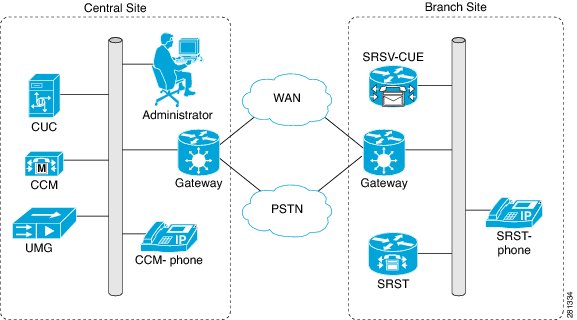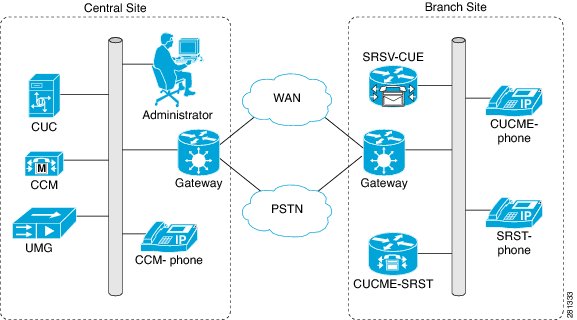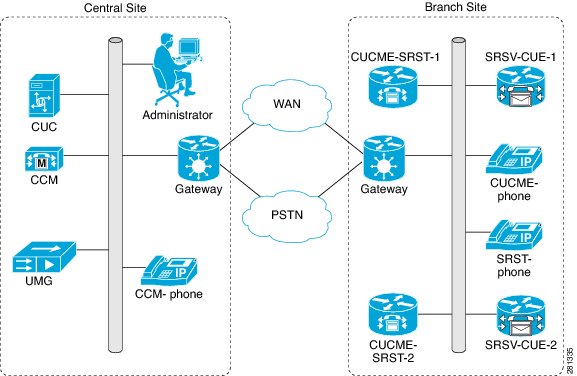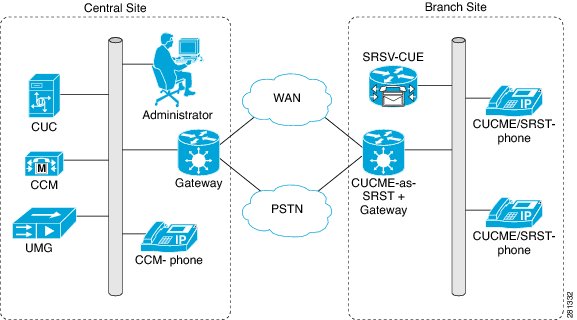

-
Administration Guide for Cisco Unified Messaging Gateway Release 8.6
-
Overview and Initial Configuration
-
Cisco Unified Messaging Gateway Overview
-
Cisco Unified Messaging Gateway Administration Interfaces
-
About the Cisco Unified Messaging Gateway GUI
-
Overview of Configuration Tasks
-
Logging In to the Cisco UMG Graphical User Interface (GUI)
-
How to Enable SMTP Support for Cisco UMG on Cisco Unity Connection
-
Configuring E-SRST Site Provisioning
-
Using the Setup Wizard
-
Supporting High Availability
-
Using the Central Call Agent Wizard to Add Cisco Unified Communications Manager Information
-
Using the Central Voicemail Server Wizard to Add Cisco Unity Connection Information
-
Using the Add Branch Voicemail Server Wizard to Add an SRSV-CUE Device
-
Configuring Users
-
Setting User Defaults
-
Configuring Groups
-
Configuring Privileges
-
Configuring Authentication, Authorization, and Accounting
-
Viewing and Removing Central Voicemail Servers
-
Viewing and Updating a Central Voicemail Server
-
Viewing the Cluster Nodes Associated With a Central Voicemail Server
-
Viewing the Call Handlers Associated With a Central Voicemail Server
-
Viewing and Removing the Central Call Agent
-
Viewing and Updating the Central Call Agent
-
Viewing the Cisco Unified SRST References
-
Viewing and Removing Branch Voicemail Servers
-
Viewing the Cluster Nodes Associated With a Central Call Agent
-
Viewing and Updating a Branch Voicemail Server
-
Managing the Branch Voicemail Server Software
-
Viewing and Provisioning Sites
-
Changing the Information for a Single Cisco Unified SRST Site
-
Changing the Information for Multiple Cisco Unified SRST Sites at Once
-
Using Site Templates
-
Creating, Changing, and Viewing a Site Template
-
Configuring Unassigned Branch Voicemail Servers
-
Changing Cisco Unified SRSV System Settings
-
- Making Updates to the System
-
Monitoring and Maintaining the System
-
Monitoring the Learned Cisco Unified Communications Manager Express Routers
-
Monitoring the Provisioning Status of a Branch Device
-
Monitoring the Voicemail Upload
-
Monitoring the Software Upgrade Status
-
Monitoring the System
-
Maintaining the Cisco UMG System
-
Viewing Reports
-
Backing Up and Restoring Data
-
Configuring Backup and Restore
-
Backing Up and Restoring Data Using the CLI
-
Saving and Reloading the Cisco Unified Messaging Gateway Configuration
-
Displaying Cisco UMG License Information
-
- Troubleshooting
- CLI Reference Information
-
Glossary
-
Overview and Initial Configuration
Table Of Contents
Cisco Unified Messaging Gateway Overview
Enhanced Survivable Remote Site Telephony (E-SRST)
Cisco Unified Survivable Remote Site Voicemail (Cisco Unified SRSV)
Introduction to Cisco Unified SRSV
Supported Cisco Unified SRSV Topologies
Cisco Unified SRSV Limitations
Limitations for Interoperating with Cisco Unified Communications Manager
Voicemail Limitations and Restrictions
Network Address Translation (NAT) Restrictions
Voicemail Backup and Restore Limitations
Live Record and Live Reply Limitations
Combined Cisco Unified SRSV and E-SRST on the Same Site
E-SRST and Cisco Unified SRSV Licenses and When to Deploy Them
Voice Profile for Internet Mail (VPIM) Networking
Cisco Unified Messaging Gateway Overview
Last updated: August 5, 2011
Cisco Unified Messaging Gateway (Cisco UMG) Release 8.6 is an application that resides on an enhanced network module (NME) or Services Ready Engine service module (SM-SRE). The module plugs into a host Cisco router running Cisco IOS software. All models are shipped from the factory with Cisco UMG Release 8.6 preinstalled.
Cisco UMG Release 8.6 supports the following features:
•
Enhanced Survivable Remote Site Telephony (E-SRST)
•
Cisco Unified Survivable Remote Site Voicemail (Cisco Unified SRSV)
•
Combined Cisco Unified SRSV and E-SRST on the Same Site
•
Voice Profile for Internet Mail (VPIM) Networking
Enhanced Survivable Remote Site Telephony (E-SRST)
The Enhanced Survivable Remote Site Telephony (E-SRST) feature is supported in Cisco UMG Release 8.5 and later versions. The E-SRST feature requires that you install E-SRST licenses, with each license supporting up to 25 sites per license. The E-SRST feature can be deployed separately or combined on a given site with Cisco Unified Survivable Remote Site Voicemail (Cisco Unified SRSV). See the "Combined Cisco Unified SRSV and E-SRST on the Same Site" section.
The E-SRST feature provides an integrated solution that supports advanced Cisco Unified Communications Manager Express-as-Cisco Unified Survivable Remote Site Telephony (CUCME-as-SRST) telephony features such as hunt groups and pick-up groups, but reduces the complex and manual configuration required at the branch site.
If deploying the E-SRST feature, the Cisco UMG system at the central site collects information from Cisco Unified Communications Manager, generates the complex configuration information required for advanced features such as hunt groups and pick-up groups, and then distributes this configuration information to the branch sites. In the event of a WAN outage, when the CUCME-as-SRST service running on the branch office routers takes over call processing, it leverages the configuration provisioned by the central site Cisco UMG system to provide enhanced Cisco Unified SRST services at the branch sites.
Figure 1 shows the supported topology model for E-SRST on a branch site. In this example, Cisco Unified SRSV is not deployed at the branch site.
Figure 1 E-SRST Only (No Cisco Unified SRSV) Topology
The E-SRST feature provides automated remote site provisioning of the following advanced telephony features in survivable mode by gathering the information from Cisco Unified Communications Manager:
•
End-user phone numbers and extensions (speed dials, lines, softkeys)
•
Voicemail and call forward configuration
•
Call routing restrictions (local and long distance, and time of day)
•
Call pickup and group pickup
•
Hunt groups
•
Pick-up groups
•
After-hours
•
Class of restrictions
•
Directory numbers
The E-SRST feature allows you to set up provisioning schedules for defining when and how often to fetch configuration information from Cisco Unified Communications Manager and provision the branch site CUCME-as-SRST routers. You can also do an on-demand provisioning to synchronize a specific CUCME-as-SRST router with the Cisco Unified Communications Manager information.
The CUCME-as-SRST configuration in the E-SRST solution enables a phone in Cisco Unified SRST mode to operate similarly to when the system is in normal Cisco Unified Communications Manager mode. The look and feel of the phone displays and softkeys in Cisco Unified SRST mode are similar to those in normal Cisco Unified Communications Manager mode.
For more information about Cisco Unified Communications Manager Express, see the documentation at: http://www.cisco.com/en/US/partner/products/sw/voicesw/ps4625/tsd_products_support_series_home.html.
E-SRST Limitations
•
Provisioning advanced E-SRST features on an original Cisco Unified SRST gateway at the branch site is not supported. In this scenario, the central E-SRST gateway does not replace the original Cisco Unified SRST with CUCME-as-SRST.
•
The E-SRST feature does not support a Cisco Unity-only or Cisco Unity Express-only messaging network. (The E-SRST feature only supports SRSV-CUE at the branch site with Cisco Unity Connection at the central site.)
•
The E-SRST feature requires Cisco Unified Communications Manager Express Release 7.1 and later.
•
The E-SRST feature does not support secure Cisco Unified SRST.
•
The E-SRST feature does not actually configure or create dial peers and translation rules. The dial peers and translation rules must be manually configured on the branch site.
•
Extension mobility on Cisco Unified Communications Manager is not supported.
Cisco Unified Survivable Remote Site Voicemail (Cisco Unified SRSV)
•
Introduction to Cisco Unified SRSV
•
Supported Cisco Unified SRSV Topologies
•
Cisco Unified SRSV Limitations
Introduction to Cisco Unified SRSV
Cisco Unified SRSV is supported in Cisco UMG Release 8.0 and later. The Cisco Unified SRSV feature requires that you install Cisco Unified SRSV licenses, with each license supporting up to 25 nodes per license. The Cisco Unified SRSV feature can be deployed separately on a given site or combined with E-SRST.
The Cisco Unified SRSV solution requires the following two components:
•
Cisco Unified Messaging Gateway-Survivable Remote Site Voicemail (commonly referred to as Cisco UMG)
The Cisco UMG component is deployed at the central site alongside Cisco Unified Communications Manager and Cisco Unity Connection. The SRSV-UMG component is deployed using Cisco UMG software with Cisco Unified SRSV licenses installed. For product versions compatible with Cisco UMG, see the Release Notes for Cisco Unified Messaging Gateway Release 8.6.
•
Cisco Unified Survivable Remote Site Voicemail-Cisco Unity Express (SRSV-CUE)
The SRSV-CUE component is deployed at the branch site alongside Cisco Unified Communications Manager Express or Cisco Unified SRST. SRSV-CUE is a separate orderable product, and has different hardware and software requirements. For more information, see the Release Notes for Cisco Unified Messaging Gateway Release 8.6.
Note
While similar to Cisco Unity Express, SRSV-CUE is a different product and provides a limited subset of features for survivable mode only. The Cisco Unified SRSV solution does not support interoperability with Cisco Unity Express.
The standalone Cisco Unified SRSV solution introduced in Cisco UMG Release 8.0 uses either original Cisco Unified SRST or CUCME-as-SRST. Original Cisco Unified SRST requires simple, very limited provisioning on the branch site gateway, but provides very limited features to support basic phone calls. CUCME-as-SRST, also known as Cisco Unified SRST Fallback Mode, provides advanced telephony features such as hunt groups and pick-up groups that are not available with original Cisco Unified SRST, but it requires more complex and manual provisioning on the branch site gateways. For information about configuring CUCME-as-SRST, see the "Configuring SRST Fallback Mode" chapter in the Cisco Unified Communications Manager Express System Administrator Guide.
The E-SRST feature introduced in Cisco UMG Release 8.5 reduces the manual provisioning required for selected advanced telephony features supported by CUCME-as-SRST. For more information, see the "Enhanced Survivable Remote Site Telephony (E-SRST)" section.
When deployed and provisioned, the SRSV-CUE system sits idle in the branch site, ready to receive calls from the Cisco Unified SRST system (either original Cisco Unified SRST or CUCME-as-SRST). The Cisco Unified SRST component (provisioned by Cisco Unified Communications Manager), also sits idle, waiting for IP phones to register with it. When a WAN outage occurs, the branch site IP phones that are registered to the central site Cisco Unified Communications Manager detect the loss of connectivity and re-home to the Cisco Unified SRST. Incoming PSTN calls to the branch site are then handled by the Cisco Unified SRST. For calls that are either no-answer or reach a busy line, the Cisco Unified SRST can forward to the Cisco Unified SRSV system. As a result, the branch site voicemail is supported during WAN outages when the central site voicemail system is unreachable.
When the WAN connection returns, the IP phones automatically re-home to the central site Cisco Unified Communications Manager. Call handling is then managed by Cisco Unified Communications Manager, and no-answer and busy calls are forwarded to the central site Cisco Unity Connection voicemail system.
Note
The documentation and product may refer to the branch site as the branch voicemail server or the SRSV-CUE device. These terms are used interchangeably and refer to the same device.
Supported Cisco Unified SRSV Topologies
Several Cisco Unified SRSV topologies are supported beginning with Cisco UMG Release 8.0. Depending on the configuration, you can have either original Cisco Unified SRST or CUCME-as-SRST (also known as Cisco Unified SRST Fallback Mode) deployed at the branch site. Note that if you are running Cisco Unified SRST at the branch site, you cannot also deploy the E-SRST feature. See Table 1 for the supported combinations of features.
Figure 2 shows a topology in which Cisco Unified SRST is deployed at the branch site. If the WAN or PSTN goes down, the SRSV-CUE at the branch site provides limited voicemail support in failover mode.
Figure 2 Cisco Unified SRSV Topology Using Cisco Unified SRST at the Branch Site
Figure 3 shows a topology where CUCME-as-SRST (also known as Cisco Unified SRST Fallback Mode) is providing call control at the branch site.
Figure 3 Cisco Unified SRSV Topology Using CUCME-as-SRST at the Branch Site
Figure 4 shows a topology where multiple CUCME-as-SRST and SRSV-CUE devices are paired for load balancing at the survivable branch site. In this scenario, the administrator uses Cisco Unified Communications Manager to divide the branch users between CUCME-SRST-1 and CUCME-SRST-2. The Cisco UMG learns about which phones are assigned to each device, and then pulls the relevant voicemail configuration from Cisco Unity Connection at the central site, and then pushes the appropriate configuration to SRSV-CUE-1 and SRSV-CUE-2 at the branch site. In the event of a WAN failure, each SRSV-CUE device will handle calls directed to it from the paired CUCME-as-SRST device.
Figure 4 Cisco Unified SRSV Topology with Multiple CUCME-as-SRST Devices Load Balanced at Remote Site
Cisco Unified SRSV Limitations
•
Limitations for Interoperating with Cisco Unified Communications Manager
•
Voicemail Limitations and Restrictions
•
Network Address Translation (NAT) Restrictions
•
Voicemail Backup and Restore Limitations
•
Live Record and Live Reply Limitations
Limitations for Interoperating with Cisco Unified Communications Manager
•
Extension mobility is not supported.
Voicemail Limitations and Restrictions
•
The following features are not supported with Cisco UMG Release 8.6 and later when using Cisco Unified SRSV:
–
Fax support
–
Addressing non-subscribers
–
Dispatch messages
–
Advanced telephony features, such as call screening
–
Updating spoken name, distribution lists, or PINs through the telephony user interface (TUI)
–
TUI administration interfaces, such as broadcast or greeting administration
–
Private distribution lists
–
Text-to-speech or voice recognition features
–
Customizing the voicemail TUI flows on a SRSV-CUE device
•
Voicemail synchronization is one-way. Voicemail received on Cisco Unity Connection is not replicated to the SRSV-CUE device.
•
The Message Waiting Indicator (MWI) for an SRSV-CUE device does not track the state of the Cisco Unity Connection mailbox.
•
Subscribers can permanently delete messages so that they will never be uploaded.
•
Voicemail upload is not synchronized with phone re-home to Cisco Unified Communications Manager.
•
Only G.711-encoded spoken names and greetings are downloaded from Cisco Unity Connection. If no spoken names or greetings are downloaded, the system uses the system defaults from Cisco Unity Connection.
•
Some class of service Cisco Unity Connection features are provisioned for all SRSV-CUE users (such as live reply, distribution list access, and message deletion behavior).
•
Composed messages are not delivered immediately to branch voicemail servers in Cisco Unified SRSV mode. They are delivered after the WAN recovers.
•
Subscribers cannot log in to SRSV-CUE devices until they set up their voicemail preferences on Cisco Unity Connection.
•
SRSV-CUE devices only support PINs in the SHA1 format. If you are upgrading to Cisco Unified SRSV from Cisco Unity Connection, ensure that all your subscribers reset their PINs so that they are saved in the SHA1 format.
Auto Attendant Limitations
•
The following auto attendant features are supported:
–
Selected Cisco Unity Connection call handler for branch auto attendant and all of its descendants
–
Local user only lookup
–
Standard greetings
–
Standard transfer options
•
There is no support for the following auto attendant features:
–
Partitions or search spaces
–
Advanced calling features, such as call screening
–
Interview handlers
–
Dispatch messages
–
Distribution lists
•
The auto attendant feature is supported with Cisco Unity Connection Release 8.0 only.
•
The SRSV-CUE auto attendant greeting is the same as the greeting of the system call handler on Cisco Unity Connection selected for the branch site.
•
Because the auto attendant greeting on SRSV-CUE is provisioned from Cisco Unity Connection, the greeting can confuse users into thinking that the function works the same way that it works for Cisco Unity Connection. However, the auto attendant functionality for SRSV-CUE has fewer features.
•
Through the SRSV-CUE auto attendant feature, subscribers can be reached using the directory service.
•
Directory service on SRSV-CUE cannot locate users if either the first or last name of the user contains a number.
Network Address Translation (NAT) Restrictions
•
Network Address Translation (NAT) is only supported at branch locations and not at the central site.
•
Only one SRSV-CUE device can be provisioned at each NAT site.
•
Only static NAT and PAT are supported. Dynamic NAT is not supported.
Voicemail Backup and Restore Limitations
•
Transport Layer Security (TLS) certificates and private keys are not backed up on SRSV-CUE devices. After restoring a backup, you must import the security certificates again.
•
To avoid creating duplicate email messages, backing up data on SRSV-CUE devices is not recommended.
Mailbox Limitations
•
If a Cisco Unity Connection user has a spoken name that is longer than ten seconds, the system will use a default spoken name in Cisco Unity Express.
•
If there is a mismatch in the codec format between Cisco Unity Connection and Cisco Unity Express (which only supports G.729 ulaw), the system will use the system default greetings and spoken names for users.
•
The system determines the mailbox size based on the size of the site template mailbox and not based on the available space on the module.
•
User IDs for SRSV-CUE devices do not support all the characters that are supported on Cisco Unity Connection. SRSV-CUE devices only support the following characters: alphanumeric, period [.], dash [-], and underscore [_].
•
User IDs cannot start with a number. User IDs can contain numbers, but cannot start with a number.
•
In Cisco Unity Connection Release 7.1.3, the system uploads messages that were deleted in Cisco Unified SRSV as new messages. Therefore, the subscriber must manually log in to his voicemail on Cisco Unity Connection and delete the messages again. In Cisco Unity Connection Release 8.0, the system uploads deleted voicemails as deleted.
Live Record and Live Reply Limitations
•
Recording can be clipped when the live record beep is played. To avoid this, do not use the speaker phone option when using the live record feature. (Speaker phones have algorithms that can stop sending voice if an incoming talk spurt of significant volume occurs. Incoming live record beeps cause the speaker phone to clip portions of the user's speech when the beep occurs.)
•
Live reply is not supported for these message types:
–
Broadcast and expired messages
–
Non-Delivery Report (NDR)/Delayed Delivery Report (DDR)
–
Messages from local General Delivery Mailbox (GDM)
Distribution Lists
•
Voice messages sent to distribution lists in survivable mode get sent to the members only after the WAN recovers.
•
The system does not provision recorded names for distribution lists.
•
Distribution list numbers can be up to 15 digits.
•
Phone extensions and E.164 numbers are limited to 15 digits for all entities, including subscribers and distribution lists.
•
Only public distribution lists are supported.
Combined Cisco Unified SRSV and E-SRST on the Same Site
Cisco UMG Release 8.5 and later supports enabling both Cisco Unified SRSV and E-SRST provisioning on the same site in certain cases. In the supported model, CUCME-as-SRST is configured on the branch site along with a SRSV-CUE device. A central call agent (Cisco Unified Communications Manager) and voicemail system (Cisco Unity Connection) is installed at the central site. These devices provide the primary telephony and voicemail services under normal conditions. A Cisco UMG at the central site monitors Cisco Unified Communications Manager and Cisco Unity Connection for changes, additions, and deletions that must be pushed to the remote branch SRSV-CUE and CUCME-as-SRST sites.
Note
Cisco UMG Release 8.5 does not support E-SRST at a branch site where original Cisco Unified SRST is used. Only CUCME-as-SRST is supported for this configuration.
Figure 5 shows the deployment model for both Cisco Unified SRSV and E-SRST that is supported in Cisco UMG Release 8.5 and later.
Figure 5 E-SRST and Cisco Unified SRSV Deployed on the Same Site
E-SRST and Cisco Unified SRSV Licenses and When to Deploy Them
Feature licenses for E-SRST, Cisco Unified SRSV, and VPIM are available in increments of 25 sites or nodes each. For example, if you are deploying 25 Cisco Unified SRSV sites, you must purchase one Cisco Unified SRSV feature license. If you are deploying 30 Cisco Unified SRSV sites, you must purchase two Cisco Unified SRSV feature licenses. For more information about feature licenses, see the Release Notes for Cisco Unified Messaging Gateway Release 8.6.
The E-SRST and Cisco Unified SRSV features can be deployed separately or together on a given site. You can configure a site for either feature or for both features depending on your needs. For each feature deployed at each site, a feature license must be purchased.
The supported call control methods on a branch site are:
•
Cisco Unified SRST, also referred to as "original" Cisco Unified SRST.
•
CUCME-as-SRST. This is also known as the Cisco Unified SRST Fallback Mode feature on Cisco Unified Communications Manager Express.
E-SRST is not required if you are using original Cisco Unified SRST and are not provisioning advanced telephony features for use in survivable mode. However, we recommend using E-SRST if you will be using advanced telephony features. For example, E-SRST is recommended if you plan to use advanced Cisco Unified Communications Manager telephony features in survivable mode.
Table 1 summarizes the different options for enabling E-SRST and/or Cisco Unified SRSV on a given site.
Table 1 Cisco UMG Release 8.6 Features and Call Control Options on a Branch Site
E-SRST only
CUCME-as-SRST
Provisioned on central Cisco Unified Communications Manager, automatically downloaded to the branch site.
No
Cisco Unified SRSV only
Cisco Unified SRST
Not applicable3
Yes
Cisco Unified SRSV only
CUCME-as-SRST
Manually provisioned on the branch site.
Yes
E-SRST and Cisco Unified SRSV
CUCME-as-SRST
Provisioned on central Cisco Unified Communications Manager, automatically downloaded to the branch site.
Yes
1 A feature license must be installed on a per-site basis for provisioning to take place.
2 Requires that you install SRSV-CUE software on the branch voicemail server.
3 Original Cisco Unified SRST does not support advanced telephony features.
Voice Profile for Internet Mail (VPIM) Networking
Voice Profile for Internet Mail (VPIM) networking has not changed in this release. For information about VPIM-specific features, see earlier versions of the Cisco UMG documentation located at http://www.cisco.com/en/US/products/ps8605/tsd_products_support_series_home.html.

 Feedback
Feedback




